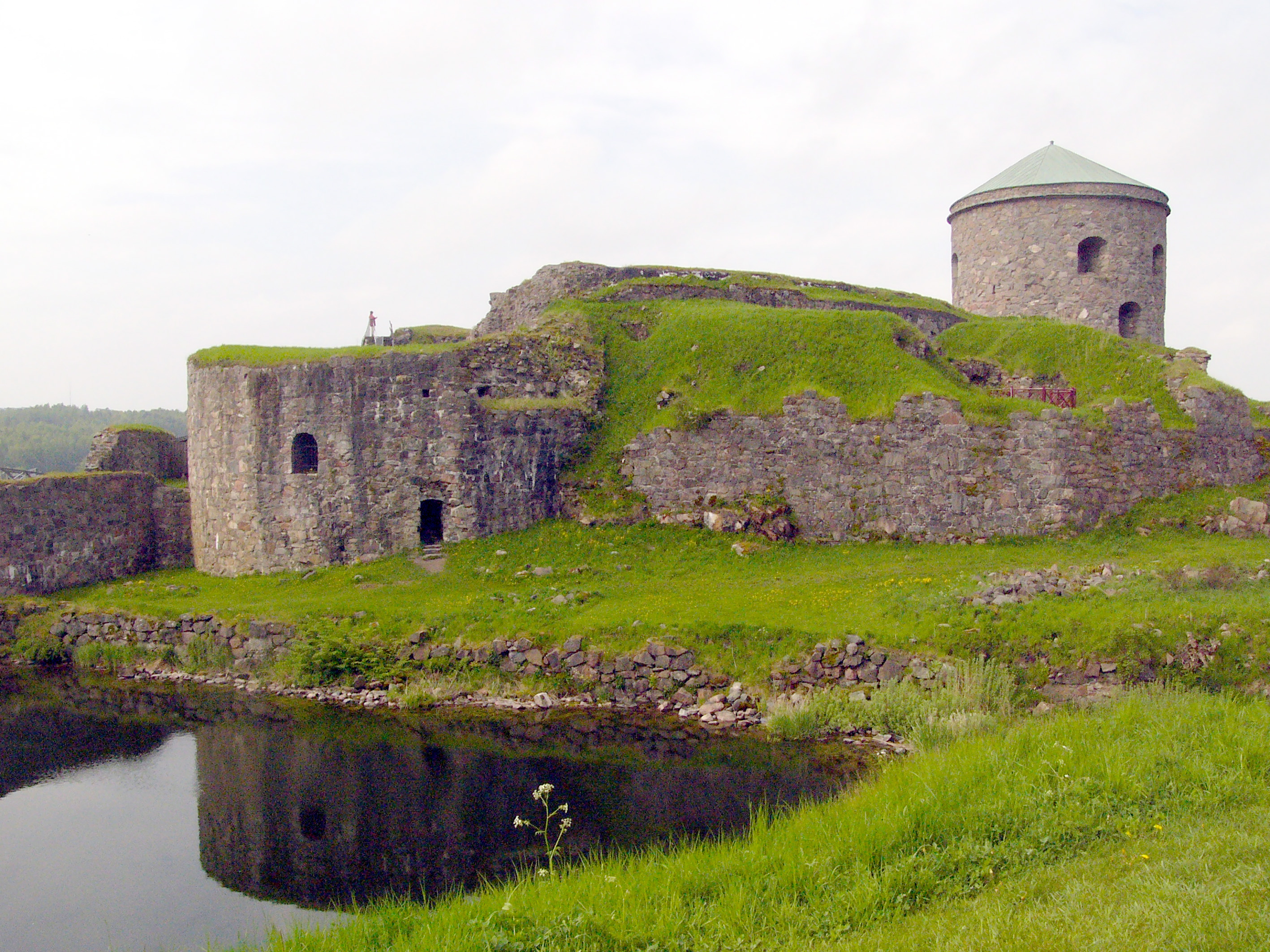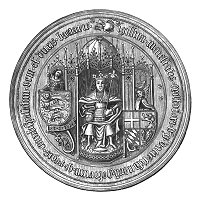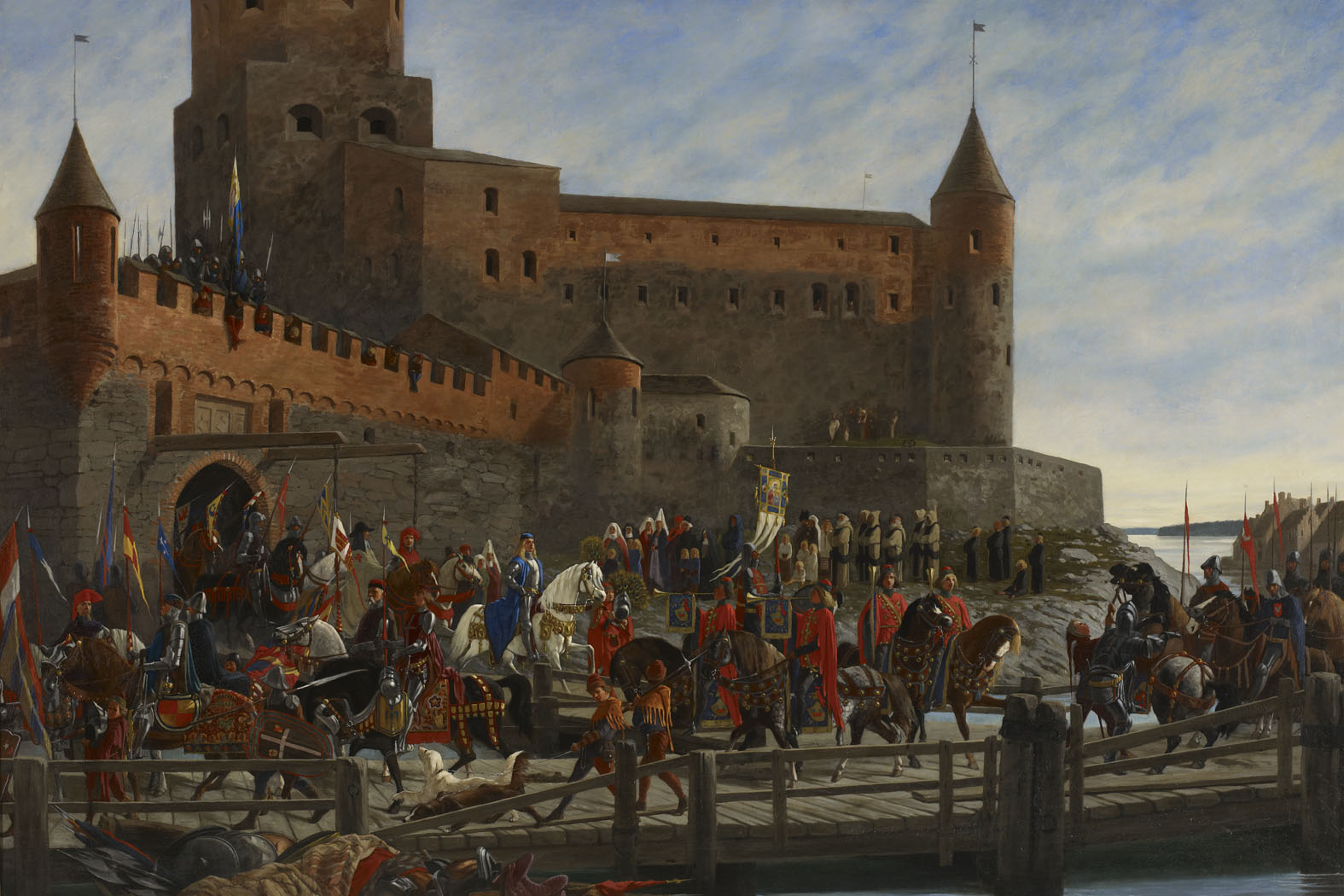|
Henrich Krummedige
Henrich Krummedige (also recorded as Hinrik, Henrik or Henry with surname variations including Krummedike and Krummendiek), was born circa 1464 in Norway and died in 1530. He was a Danish-Norwegian nobleman and a member of both the Norwegian and Danish National Councils ( ''Rigsråd'') and played an extensive role in the politics of the era. He served as commanding officer of the Bohus Fortress in Norway from 1489 to 1503. Family and youth Krummedige was Hartvig Krummedige’s son by a second marriage. He is believed to have been born in Norway. In about 1493 he married Anne Jørgensdatter Rud, daughter of Danish National Councilor Jørgen Mikkelsen Rud of Vedby and Kirstine Eriksdatter Rosenkrantz. Her nephews included Otte Brahe, who was the son of her sister, Sophie Jørgensdatter Rud (1488-1555). Career In 1484 or 85 Krummedige was knighted and entered service in 1487 at Akershus Fortress. In 1489 he was placed in charge of the strategically important Norwegian border d ... [...More Info...] [...Related Items...] OR: [Wikipedia] [Google] [Baidu] |
Norway
Norway, officially the Kingdom of Norway, is a Nordic country in Northern Europe, the mainland territory of which comprises the western and northernmost portion of the Scandinavian Peninsula. The remote Arctic island of Jan Mayen and the archipelago of Svalbard also form part of Norway. Bouvet Island, located in the Subantarctic, is a dependency of Norway; it also lays claims to the Antarctic territories of Peter I Island and Queen Maud Land. The capital and largest city in Norway is Oslo. Norway has a total area of and had a population of 5,425,270 in January 2022. The country shares a long eastern border with Sweden at a length of . It is bordered by Finland and Russia to the northeast and the Skagerrak strait to the south, on the other side of which are Denmark and the United Kingdom. Norway has an extensive coastline, facing the North Atlantic Ocean and the Barents Sea. The maritime influence dominates Norway's climate, with mild lowland temperatures on the se ... [...More Info...] [...Related Items...] OR: [Wikipedia] [Google] [Baidu] |
Christopher Of Bavaria
Christopher of Bavaria (26 February 1416 – 5/6 January 1448) was King of Denmark (1440–48, as Christopher III), Sweden (1441–48) and Norway (1442–48) during the era of the Kalmar Union. Biography Coming to power He was the son of John, Count Palatine of Neumarkt (1383–1443) and Catherine of Pomerania (c. 1390–1426). Catherine was the daughter of Wartislaw VII, Duke of Pomerania in Pomerania-Stolp, and sister of the Scandinavian king, Eric of Pomerania. Count Palatine John was a son of King Rupert of Germany (1352–1410). Christopher was probably born at Neumarkt in der Oberpfalz in Upper Palatinate, in Bavaria, Germany. In 1445, Christopher married Dorothea of Brandenburg (1430 – 25 November 1495) in Copenhagen. Eric of Pomerania was deposed as king of Denmark and Sweden in 1439. Eric's nephew, Christopher, who was rather unfamiliar with Scandinavian conditions, was elected by the Danish State Council as the successor to his uncle, first as regent from 1439, ... [...More Info...] [...Related Items...] OR: [Wikipedia] [Google] [Baidu] |
Trøndelag
Trøndelag (; sma, Trööndelage) is a county in the central part of Norway. It was created in 1687, then named Trondhjem County ( no, Trondhjems Amt); in 1804 the county was split into Nord-Trøndelag and Sør-Trøndelag by the King of Denmark-Norway, and the counties were reunited in 2018 after a vote of the two counties in 2016. The largest city in Trøndelag is the city of Trondheim. The administrative centre is Steinkjer, while Trondheim functions as the office of the county mayor. Both cities serve the office of the county governor; however, Steinkjer houses the main functions. Trøndelag county and the neighbouring Møre og Romsdal county together form what is known as Central Norway. A person from Trøndelag is called a ''trønder''. The dialect spoken in the area, trøndersk, is characterized by dropping out most vowel endings; see apocope. Trøndelag is one of the most fertile regions of Norway, with large agricultural output. The majority of the production ends ... [...More Info...] [...Related Items...] OR: [Wikipedia] [Google] [Baidu] |
Thing (assembly)
A thing, german: ding, ang, þing, enm, thing. (that is, "assembly" or folkmoot) was a governing assembly in early Germanic society, made up of the free people of the community presided over by a lawspeaker. Things took place at regular intervals, usually at prominent places that were accessible by travel. They provided legislative functions, as well as being social events and opportunities for trade. In modern usage, the meaning of this word in English and other languages has shifted to mean not just an assemblage of some sort but simply an object of any sort. Earliest reference and etymology The first detailed description of a thing was made by Tacitus in AD 98. Tacitus suggested that the things were annual delegate-based meetings that served legal and military functions. The oldest written reference of the thing is on a stone pillar found along Hadrian's Wall at Housestead in the UK. It is dated AD 43-410 and reads: "DEO MARTI THINCSO ET DUABUS ALAISIAGIS BEDE ET FI ... [...More Info...] [...Related Items...] OR: [Wikipedia] [Google] [Baidu] |
Hamar
Hamar is a List of cities in Norway, town in Hamar Municipality in Innlandet Counties of Norway, county, Norway. Hamar is the administrative centre of Hamar Municipality. It is located in the Districts of Norway, traditional region of Hedmarken. The town is located on the shores of Mjøsa, Norway's largest lake. Historically, it was the principal city of the former Hedmark county which is now part of the larger Innlandet county. The town of Hamar lies in the southwestern part of the municipality, and the urban area of the town actually extends over the municipal borders into both Ringsaker and Stange municipalities. The town has a population (2021) of 28,535 and a population density of . About and 2,109 residents within the town are actually located in Ringsaker Municipality and another and 305 residents of the town are located within Stange Municipality. General information Name The municipality (originally the town) is named after the old farm ( non, Hamarr). The Middle Ag ... [...More Info...] [...Related Items...] OR: [Wikipedia] [Google] [Baidu] |
Charles VIII Of Sweden
Charles VIII ( sv, Karl; 1408–1470), contemporaneously known as Charles II and called Charles I in Norwegian context, was king of Sweden (1448–1457, 1464–1465 and 1467–1470) and king of Norway (1449–1450). Regnal name Charles was the second Swedish king by the name of Charles (Karl). ''Charles VIII'' is a posthumous invention, counting backwards from Charles IX (r. 1604–1611) who adopted his numeral according to a fictitious history of Sweden. Six others before Charles VII are unknown to any sources before Johannes Magnus's 16th century book ', and are considered his invention. Charles was the first Swedish monarch of the name to actually use a regnal number as ''Charles II'' (later retrospectively renumbered VIII), on his wife's tombstone (1451) at Vadstena. Early life Karl Knutsson was born in October 1408 or 1409, at Ekholmen Castle, the son of Knut Tordsson (Bonde), knight and member of the privy council (''riksråd''), and Margareta Karlsdotter (Sparre av To ... [...More Info...] [...Related Items...] OR: [Wikipedia] [Google] [Baidu] |
Christian I Of Denmark
Christian I (February 1426 – 21 May 1481) was a Scandinavian monarch under the Kalmar Union. He was king of Denmark (1448–1481), Norway (1450–1481) and Sweden (1457–1464). From 1460 to 1481, he was also duke of Schleswig (within Denmark) and count (after 1474, duke) of Holstein (within the Holy Roman Empire). He was the first king of the House of Oldenburg. In the power vacuum that arose following the death of King Christopher of Bavaria (1416–1448) without a direct heir, Sweden elected Charles VIII of Sweden (14081470) king with the intent to reestablish the union under a Swedish king. Charles was elected king of Norway in the following year. However the counts of Holstein made the Danish Privy Council appoint Christian as king of Denmark. His subsequent accessions to the thrones of Norway (in 1450) and Sweden (in 1457), restored the unity of the Kalmar Union for a short period. In 1463, Sweden broke away from the union and Christian's attempt at a reconquest res ... [...More Info...] [...Related Items...] OR: [Wikipedia] [Google] [Baidu] |
Tønsberg Fortress
Tønsberg Fortress (''Tunsberghus festning'') was a medieval fortress and castle, located in Tønsberg, Norway which was defended by the fortress for over 300 years. It includes ruins from ''Castrum Tunsbergis'', Norway's largest castle in the 13th century, originally built by King Håkon IV, the grandson of King Sverre. History Dating in 871, Tønsberg is commonly believed to have been the oldest Norwegian town and one of the oldest recorded fortified locations in Norway. According to Snorri Sturluson, Tønsberg was founded before the Battle of Hafrsfjord under which King Harald I of Norway united Norway under his rule. Tønsberg was an important trading center and site of the Haugating, the Thing (assembly) for Vestfold and one of Norway's most important places for the proclamation of kings. In the 13th century, King Haakon Haakonson built a castle, ''Tunsberghus'', at the location of the modern Tønsberg municipality. It was located at what was formerly one of the most imp ... [...More Info...] [...Related Items...] OR: [Wikipedia] [Google] [Baidu] |
Alsak Bolt
Aslak Harniktsson Bolt (c. 1380 – 1450) was a 15th-century Norwegian priest who served as Archbishop of the Nidaros. His parents were Harnikt Henningsson and Sigrid Aslaksdatter Bolt. His mother was a member of a Norwegian noble family. He served as archbishop of Nidaros from about 1427 to 1450. He is most known for his detailed register of properties and incomes of the archdiocese, commonly known as ''Aslak Bolt's cadastre ''Aslak Bolt's cadastre'' ( no, Aslak Bolts jordebog; written 1432–1433) is a Norwegian cadastre, a detailed register of properties and incomes of the Archdiocese of Nidaros. History Aslak Bolt's cadastre was a register of land ownership w ...'' (''Aslak Bolts jordebok'') from 1432 to 1433. The properties listed included thousands of farms, and the survey has been an important and primary historical source from the period. References Year of birth unknown 1450 deaths 15th-century Roman Catholic archbishops in Norway Year of birth un ... [...More Info...] [...Related Items...] OR: [Wikipedia] [Google] [Baidu] |
Oslo
Oslo ( , , or ; sma, Oslove) is the capital and most populous city of Norway. It constitutes both a county and a municipality. The municipality of Oslo had a population of in 2022, while the city's greater urban area had a population of in 2019, and the metropolitan area had an estimated population of in 2021. During the Viking Age the area was part of Viken. Oslo was founded as a city at the end of the Viking Age in 1040 under the name Ánslo, and established as a ''kaupstad'' or trading place in 1048 by Harald Hardrada. The city was elevated to a bishopric in 1070 and a capital under Haakon V of Norway around 1300. Personal unions with Denmark from 1397 to 1523 and again from 1536 to 1814 reduced its influence. After being destroyed by a fire in 1624, during the reign of King Christian IV, a new city was built closer to Akershus Fortress and named Christiania in honour of the king. It became a municipality ('' formannskapsdistrikt'') on 1 January 1838. The city fu ... [...More Info...] [...Related Items...] OR: [Wikipedia] [Google] [Baidu] |
Akershus
Akershus () is a traditional region and current electoral district in Norway, with Oslo as its main city and traditional capital. It is named after the Akershus Fortress in Oslo. From the middle ages to 1919, Akershus was a fief and main county that included most of Eastern Norway, and from the 17th century until 2020, Akershus also had a more narrow meaning as a (sub) county that included most of the Greater Oslo Region. After 2020 the former county of Akershus was merged into Viken along with the former counties of Østfold and Buskerud. In 2022 the Storting voted to dissolve Viken and reestablish Akershus county. Originally Akershus was one of four main fiefs in Norway and included almost all of Eastern Norway. The original Akershus became a main county (''Stiftamt'' or ''Stift'') in 1662 and was sometimes also known as ''Christiania Stift''. It included several subcounties (''Amt'' or ''Underamt''); in 1682 its most central areas, consisting of modern Oslo and Akershus, beca ... [...More Info...] [...Related Items...] OR: [Wikipedia] [Google] [Baidu] |



.jpg)



